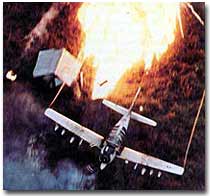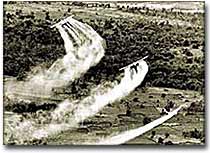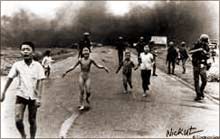55b. Years of Escalation: 1965-68

Along with Agent Orange, the substance known as napalm was used to clear forest growth as well as inflict heavy damages upon North Vietnamese forces. Essentially gasoline in gel form, napalm was extremely flammable and resulted in devastating fires.
It was David vs. Goliath, with U.S. playing Goliath.
On August 2, 1964, gunboats of North Vietnam allegedly fired on ships of the United States Navy stationed in the Gulf of Tonkin. They had been sailing 10 miles off the coast of North Vietnam in support of the South Vietnamese navy.
When reports that further firing occurred on August 4, President Johnson quickly asked Congress to respond. With nearly unanimous consent, members of the Senate and House empowered Johnson to "take all necessary measures" to repel North Vietnamese aggression. The Tonkin Gulf Resolution gave the President a "blank check" to wage the war in Vietnam as he saw fit. After Lyndon Johnson was elected President in his own right that November, he chose escalate the conflict.
Operation Rolling Thunder
In February 1965, the United States began a long program of sustained bombing of North Vietnamese targets known as Operation Rolling Thunder. At first only military targets were hit, but as months turned into years, civilian targets were pummeled as well.
The United States also bombed the Ho Chi Minh trail, a supply line used by the North Vietnamese to aid the Vietcong. The trail meandered through Laos and Cambodia, so the bombing was kept secret from the Congress and the American people. More bombs rained down on Vietnam than the Allies used on the Axis powers during the whole of World War II.
Additional sorties delivered defoliating agents such as Agent Orange and napalm to remove the jungle cover utilized by the Vietcong. The intense bombardment did little to deter the communists. They continued to use the Ho Chi Minh trail despite the grave risk. The burrowed underground, building 30,000 miles of tunnel networks to keep supply lines open.
Ground Troops

Often unable to see the enemy through the dense growth of Vietnam's jungles, the U.S. military sprayed a chemical herbicide known as "Agent Orange" in an attempt to destroy the trees. Currently, debate rages on whether or not exposure to this compound is responsible for disease and disability in many Vietnam veterans.
It soon became clear to General William Westmoreland, the American military commander, that combat troops would be necessary to root out the enemy. Beginning in March 1965, when the first American combat troops waded ashore at Danang, the United States began "search and destroy" missions.
One of the most confounding problems faced by U.S. military personnel in Vietnam was identifying the enemy. The same Vietnamese peasant who waved hello in the daytime might be a VC guerrilla fighter by night. The United States could not indiscriminately kill South Vietnamese peasants. Any mistake resulted in a dead ally and an angrier population.
Search and destroy missions were conducted by moving into a village and inspecting for any signs of Vietcong support. If any evidence was found, the troops would conduct a "Zippo raid" by torching the village to the ground and confiscating discovered munitions. Most efforts were fruitless, as the VC proved adept at covering their tracks. The enemy surrounded and confounded the Americans but direct confrontation was rare.

The media played an important part in shaping the public's opinion towards the conflict in Vietnam. Television brought the horrors of war into millions of homes, as did photos like this one of a young Vietnamese girl fleeing a napalm bombing.
By the end of 1965, there were American 189,000 troops stationed in Vietnam. At the end of the following year, that number doubled. Casualty reports steadily increased. Unlike World War II, there few major ground battles.
Most Vietnamese attacks were by ambush or night skirmishes. Many Americans died by stepping on landmines or by triggering booby traps. Although Vietnamese body counts were higher, Americans were dying at rate of approximately 100 per week through 1967. By the end of that year there were nearly 500,000 American combat troops stationed in Vietnam.
General Westmoreland promised a settlement soon, but the end was not in sight.






